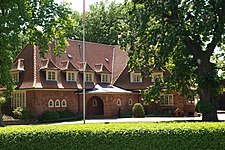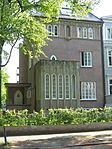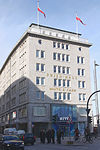Hermann Höger
Hermann Höger (born January 15, 1882 in Bekenreihe near Elmshorn , † July 13, 1950 in Hamburg ) was a German architect . He is considered one of the representatives of North German brick expressionism .
Life
Höger was one of six children of a small farmer who ran a carpentry. Two of his brothers also took up building trades. His brother Fritz (1877–1949), who was four and a half years older , also worked as an architect in Hamburg and became famous for building the Chilehaus . Fritz Höger promoted his brother's training at the building trade school and took him into his office from 1910 to 1912, where he received further training under the guidance of Ferdinand Sckopp . The design of the entrance area for Landhaus Tolle has been handed down from this period.
During his studies, Höger lived with his sister Maria in Rellingen , who was married to a carpenter. His wife Emmi, who died early, is buried in the Rellingen cemetery. One of his early works is the clinker stele on the memorial at the Rellinger Church, which was inaugurated in 1923 and whose ceramic jewelry was designed by the sculptor Ludwig Kunstmann , with whom Höger worked several times.
Höger set up his first office at Langen Reihe 29 in Hamburg-St. Georg a. Fritz Schumacher commissioned him to work on the interior of the main restaurant in Hamburg's Stadtpark , which was completed in 1924. The health department at Besenbinderhof followed in 1925 as a municipal contract. On the difficult site directly on the edge of the Geest , he erected a building with an expressionist, strongly vertically structured clinker brick facade.
Höger was appointed to the Association of German Architects (BDA), which had refused his brother Fritz admission. Various villa buildings followed from 1925 and finally his own house at Brabandstrasse 1 in Hamburg-Alsterdorf . Here he built a double house with expressionistic and Gothic elements. In Rellingen and Rendsburg, other buildings were built, some together with other architects.
At the end of the 1920s, Höger turned more and more to building settlements and building small apartments.
- On the Veddel , the city under Schumacher planned a modern, workplace-oriented housing estate. The basic urban structure and the number of floors were given. The various architects were responsible for designing the individual building blocks. The developer was not the city, but the union's own non-profit small housing construction company Groß-Hamburg (GKB), a predecessor of the later Neue Heimat . Together with the architects' office Elingius and Schramm, Höger planned the houses Immanuelplatz 11-13 / Immanuelstieg / Veddeler Brückenstraße from 1926 to 1927 , which have characteristic diamond-shaped skylights and a hatch opening for coal transport.
- Schumacher had reformed the development plan for Hamburg-Barmbek-Nord originally drawn up in 1914 by loosening up development with extensive green areas. Höger took over 1927-1930 with Karl Schneider tasks in apartment building in the area Habichtsplatz / Schwalbenplatz for the GKB (southwest block). To the north of Habichtplatz he built the block perimeter development at Otto-Speckter-Straße / Dennerstraße and Mildestieg / Dennerstraße.
- Based on a development plan from 1927, after the end of the global economic crisis in the mid-1930s, 3750 apartments were built on the Horner Geest southeast of the racecourse along Washingtonallee. Höger built 278 apartments with Richard Opitz and Hans Mütel for the non-profit housing association "Freie Stadt" (today: SAGA group of companies ).
- In the garden city of Alsterdorf , a residential estate with 304 single-family houses was built between Heilholthamp and the U-Bahn between 1935 and 1938. Höger was responsible for the overall planning and he took on the planning of several houses.
In addition to his work in housing development, he built several private single-family houses and took part in competitions:
- 1925: Competition design for a sports hall in the city park
- 1937: Competition design for an administration building for the fire office (in collaboration with Gustav Burmester ; awarded 2nd prize)
When the Second World War broke out, Höger - like several other Hamburg architects - was engaged in planning by Konstanty Gutschow , the official "Architect for the Redesign of the Hanseatic City of Hamburg".
Hermann Höger died in Hamburg in 1950.
Works
| photo | Construction year | object | Explanation |
|---|---|---|---|
| 1923 |
for the fallen of the First World War on the church square in Rellingen |
The clinker column designed by Höger has ceramic plates and sculptures by Ludwig Kunstmann . Hopp is named in the literature as Höger's employee for the memorial . | |
| 1925 |
|
Expressionist furniture designed for a private individual, made by Ludwig Kunstmann | |
| after 1925 |
Rellingen, Hauptstrasse 17 |
erected for bus operator Julius Martens in Schröderschen Park. Lange assigns the building to Höger. | |
| 1925 |
|
together with Joerges and Wehde | |
| 1925-1926 |
Besenbinderhof 41 |
Expressionist facade with a strong vertical structure. Höger attracted public attention with this building on a problematic property on the Geestrand. List of monuments Hamburg (as of 2020), No. 13621 |
|
| 1925-1926 |
Southwest block Habichtplatz / Schwalbenplatz |
Together with Karl Schneider Hamburg Monument List, No. 23487 |
|
| 1927 |
in Barmbek Nord |
The houses on the street side are made of clinker bricks and plastered on the inner courtyard. There is a small wash house in the inner courtyard on Otto-Speckter-Straße. Hamburg Monument List, No. 23154. |
|
| 1926-1927 |
in Groß-Borstel |
The house at Brabandstrasse 1, double house Landhaus Höger (corner plot to Alsterdorfer Damm) was built by Höger as his own residence. Hamburg Monument List (as of 2020), No. 20320 |
|
| 1926-1927 |
in Rendsburg |
||
| 1926-1927 |
( → location ) |
together with Elingius and Schramm ; Immanuelplatz 11–13 / Immanuelstieg / Veddeler Brückenstraße; Flat roof buildings without a basement; Winch hatches for the transport of the fuel. Hamburg Monument List, No. 14457. |
|
| 1927 |
Heimhuder Strasse 39 |
Höger continued the renovation work by Kurt F. Schmidt in 1927 and took on the expressionist facade design of the building. | |
| 1929 |
Kieler Strasse 27 in Rendsburg |
||
| 1929-1931 |
Barmbek Nord |
The houses on the street side are made of clinker bricks and plastered on the inner courtyard. Hamburg Monument List, No. 23616 |
|
| 1935 |
Jungfernstieg 51 / Colonnaden 1, Hamburg |
together with Elingius and Schramm Hamburg Monument List (as of 2020), No. 12780 |
|
| 1935 |
Bergedorfer Straße / Vierlandenstraße / At the pool |
List of monuments Hamburg (status 2013), No. 28660 | |
| 1935-1938 |
( → location ) |
Here, the individual single-family houses were realized by different architects, and Höger provided the overall planning. | |
| 1936-1940 |
Washingtonallee / Sandkamp / Stengelestrasse |
Together with Müthel and Opitz for SAGA; The buildings were partially destroyed and rebuilt during the war. The impression has been significantly influenced by energy renovations in recent years. | |
| before 1939 |
in the Hamburg city park |
Designed as part of the activity for Konstanty Gutschow | |
| 1950-1951 |
Am Radeland 125, Bostelbek |
1950/1 together with Otto Koch Hamburg Monument List (as of 2020), No. 28291 |
literature
- Karin von Behr: Höger, Hermann . In: Franklin Kopitzsch, Dirk Brietzke (Hrsg.): Hamburgische Biographie . tape 6 . Wallstein, Göttingen 2012, ISBN 978-3-8353-1025-4 , p. 195-196 .
Web links
Individual evidence
- Hans Harms / Dirk Schubert: Living in Hamburg. A city guide to 111 selected examples . Hans Christians Verlag, Hamburg 1989, ISBN 3-7672-1079-7 . (here referenced as Harms / Schubert )
- Ralf Lange: Architecture in Hamburg. The great architecture guide . Junius Verlag, Hamburg 2008, ISBN 978-3-88506-586-9 . (referenced here as Lange )
- Hermann Hipp : Free and Hanseatic City of Hamburg. History, culture and urban architecture on the Elbe and Alster . DuMont, Cologne 1989, ISBN 3-7701-1590-2 . (referenced here as Hipp )
- ↑ Artist card from the time
- ^ Garden routes: Rellingen cemetery , accessed on April 13, 2013
- ↑ Harms / Schubert, p. 97 ff.
- ↑ Lange: E 71.1
- ↑ Harms / Schubert, p. 244 ff.
- ↑ Harms / Schubert, p. 78 ff.
- ↑ Harms / Schubert, p. 253 ff.
- ↑ Archive link ( Memento of the original from April 14, 2013 in the Internet Archive ) Info: The archive link was inserted automatically and has not yet been checked. Please check the original and archive link according to the instructions and then remove this notice.
- ↑ Quoting an article in the Pinnerberger Tageblatt from May 3, 2005
- ^ Lange: I 52
- ↑ Hipp, p. 265
- ↑ List of monuments as of February 26, 2020
- ↑ Hipp p. 441
- ↑ Hipp p. 442; Long F64, F64.2
- ↑ Hipp p. 400; Long I 18
- ↑ List of monuments as of February 26, 2020
- ↑ Hipp p. 278
- ↑ Hipp p. 442; Long F64, F64.2
- ↑ List of monuments as of February 26, 2020
- ↑ Hamburg Monument List ( Memento of the original dated June 2, 2015 in the Internet Archive ) Info: The archive link was inserted automatically and has not yet been checked. Please check the original and archive link according to the instructions and then remove this notice. from May 1, 2013
- ↑ 75 Years of Alsterdorf Garden City , accessed on April 13, 2013.
- ↑ Harms / Schubert p. 80
- ↑ Listed in the table of contents of the 1939 annual edition of the Reich Youth Leadership with watercolors by Alfred Thon
- ↑ List of monuments as of February 26, 2020
| personal data | |
|---|---|
| SURNAME | Höger, Hermann |
| BRIEF DESCRIPTION | German architect |
| DATE OF BIRTH | January 15, 1882 |
| PLACE OF BIRTH | Bekenzeile at Elmshorn |
| DATE OF DEATH | July 13, 1950 |
| Place of death | Hamburg |











